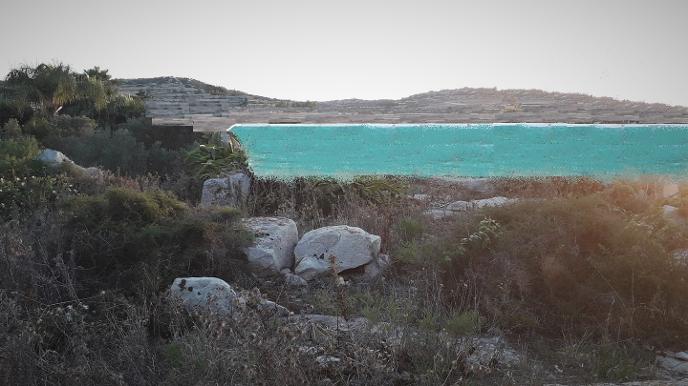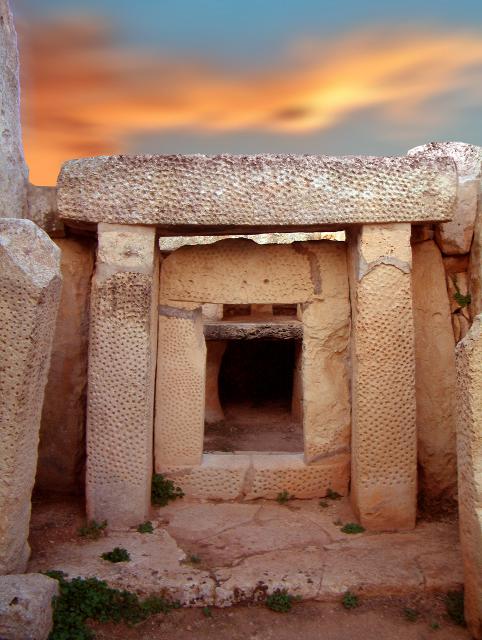THE TAL-QADI TEMPLE
The Tal-Qadi Temple
Tal-Qadi hill is situated between Salina and Burmarrad. It features an interesting host of remains which include a prehistoric temple, an ancient quarry, and Paleo-Christian Catacombs.
The presence of these Catacombs along with a dense quantity of pottery and pebbles further up the hill denote sustained Roman activity. The immediate vicinity of the Salt Pans and other Catacombs at Salina further suggest that one or more Roman buildings might once have stood here.
One must bear in mind that the hill was actually a shoreline, since the Burmarrad plain was still a harbour during the Roman period and afore.
This would have found the temple and Catacombs just overlooking the shore and facing San Pawl Milqi (in Burmarrad), where other important ruins survive. The nearby Salina catacombs would have similarly been on the shoreline, overlooking the water.
The Tal-Qadi Temple was originally built overlooking the sea.
These graphics are intended to give an idea of what the area would have looked like, but are not to be taken as a definitive representation of the exact shorelines.
These graphics are intended to give an idea of what the area would have looked like, but are not to be taken as a definitive representation of the exact shorelines.

The earliest use of the tal-Qadi site is estimated to be around 4000 BC, however the temple has been dated to between 3300-3000 BC.
Although most have heard of other larger temples, this relatively unknown and certainly overlooked site is of considerable importance.
Tal-Qadi Temple layout (1)
The temple is unique because it was built oriented to the North-East rather than South or South-East, hence unlike most other such temples of its kind.
Discovered in 1916 by Henry Sant, and excavated 11 years later by Sir Temi Zammit, the site generated a just-as-unique find.
This came in the form of a limestone fragment containing incised segments with stars and other symbols.

The Lunar Stone and reconstruction by Chris Micallef (2)
Academics have tried to rebuild the missing remainder of what most agree is some form of lunar calendar or zodiac.
Some have suggested that it could have been the precursor of an astral compass / map which could be used for navigation, amidst several other theories conjectured.
Other than the tal-Qadi stone, no similar artefacts have been discovered locally, and like the temples, marks the dawn of civilisation.
What is known and proven, both by this stone, as well as the orientation of the said temples across our islands, is that people of the time possessed an advanced knowledge and understanding of the heavens and movements of the sun, moon and relations between stars and constellations.
This knowledge is epitomised by the Mnajdra temple, in the south-east of Malta, which is a precise stone calendar built around 300 years before the Tal-Qadi temple.

The Mnajdra Temple - The original structure at tal-Qadi would have originally looked similar. (3)
Despite the importance of the tal-Qadi temple, the site is mostly overgrown and in very bad shape. Nothing remains of its megalithic portals and most of its walls are long gone albeit a remaining few, broken and collapsed.
Above: The Tal-Qadi Temple - The Stairway is a 20th Century addition
Below - Very little of the temple's interior has survived the ravages of time
Click images to enlarge (opens a new tab)
This collapsed outer wall is perhaps the most significant portion of the temple to survive.
Notes & References:
(1). Temple layout plan from Irkejjen Storici (Il-Mument), by Vincent Zammit
(2). The Oracle (Issue 2) - Drawing by Chris Micallef. Central photo in our collage is by Daniel Cilia
(3). Mnajdra photo by master photographer Gino Galea - Wikimedia Commons
(1). Temple layout plan from Irkejjen Storici (Il-Mument), by Vincent Zammit
(2). The Oracle (Issue 2) - Drawing by Chris Micallef. Central photo in our collage is by Daniel Cilia
(3). Mnajdra photo by master photographer Gino Galea - Wikimedia Commons
Designed by http://www.mitchinson.net

